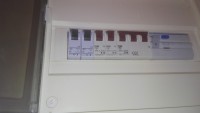FAQ
TL;DR: 400 V three-phase delivers 73 % more voltage than a 230 V single phase, enabling the same 3 kW motor to pull 42 % less current [Elektroda, neo_dc, post #5372492] "Voltage is a potential difference" [Elektroda, neo_dc, post #5375683]
Why it matters: This FAQ helps DIYers and tenants safely tap 230 V or 400 V, size cables, and reverse motors without frying tools or fuses.
Quick Facts
• EU nominal voltages: 230 V phase-to-neutral, 400 V phase-to-phase (IEC 60038).
• Voltage tolerance: −10 %/+5 % ⇒ 207–241.5 V RMS [Elektroda, Paweł Es., post #5378606]
• Current per 16 A socket: max ≈ 3.7 kW at 230 V [Rafael22, #16874056].
• Star vs delta: star lowers coil voltage by √3 (≈ 42 %) [Elektroda, neo_dc, post #5720958]
• Single-phasing can overheat windings in <5 min and trip thermals [Elektroda, Paweł Es., post #5744205]
Why isn’t 3 × 230 V equal to 690 V in a 400 V socket?
The three phase waveforms are 120 ° apart; vector addition gives √3 × 230 V ≈ 400 V, not simple addition [Elektroda, neo_dc, post #5372492]
How do I reverse a three-phase motor’s direction?
Swap any two phase conductors in the plug: L1↔L2, L1↔L3, or L2↔L3. The 120 ° sequence changes, so the magnetic field spins the other way [Elektroda, Paweł Es., post #5378606]
Do I need the neutral (N) wire for a star-connected motor?
Not for a balanced three-phase motor; currents cancel in the neutral, so it can remain disconnected [Elektroda, Quarz, post #5384937]
What happens if one phase drops out (single-phasing)?
The motor stalls, draws up to 6× nominal current, overheats, and may burn windings within minutes [Elektroda, Paweł Es., post #5744205]
Which cable size for a 3.7 kW (16 A) circuit?
Use 3×2.5 mm² Cu (plus PE) for sockets; its ampacity ≈ 21 A in-wall, meeting 16 A breaker requirements [Rafael22, #16874056].
Can I power 230 V outlets from any phase in a 5-wire supply?
Yes. Split outlets across L1, L2, L3 to balance load; each gives 230 V to N [Elektroda, bandzior2, post #5605596]
Is a 3 kW, 400 V motor ‘stronger’ than a 3 kW, 230 V motor?
Power is identical, but the 400 V unit draws ≈ 7.5 A versus 13 A at 230 V—thinner cables, cooler fuses [Elektroda, Paweł Es., post #5744205]
Why did my saw’s thermal sensor never trip before the motor failed?
Likely a faulty thermal cut-out or mis-wired sensor. Lack of PE does not block thermal operation [Elektroda, neo_dc, post #5778055]
How do I adapt a 5-pin plug to a 4-wire (old TN-C) supply?
Bridge PE to N inside the socket, connect the three phases, and label the outlet; this meets TN-C rules but offers limited shock protection [Elektroda, neo_dc, post #5717177]
Can I ground equipment by driving my own earth stake?
Yes, but the rod must reach low-resistance soil (<30 Ω). Verify with an earth-tester; ad-hoc stakes rarely pass inspection [BS 7671].
How many 1.2 kW cryptocurrency rigs can one 16 A socket handle?
At 230 V, 16 A supplies 3.68 kW, so safely two rigs (2.4 kW) per circuit, leaving 1.3 kW headroom [Rafael22, #16874056].
Quick 3-step test to map breakers to rooms?
- Switch off all branch breakers except one.
- Check which lights/sockets still work.
- Label the breaker and repeat for each circuit. This avoids guesswork [Freddy, #16874073].
Edge case: what if neutral opens but PE remains?
Appliances can see full 400 V across live and floating parts, blowing electronics and risking shock—use PEN bonding or RCDs to mitigate [IEC 60364].
Is the fifth pin in a 400 V plug ever a live conductor?
No. It is always PE (protective earth); live conductors are the three slim pins, and N (if present) is thicker [Elektroda, bandzior2, post #5960303]
What’s the legal voltage range I should measure at my sockets?
European low-voltage networks must stay within 207–253 V; frequent deviations merit a utility report [Elektroda, Paweł Es., post #5378606]



